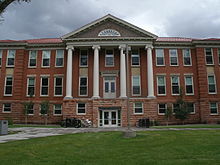User:JPRiley/Cooper
| This is not a Wikipedia article: It is an individual user's work-in-progress page, and may be incomplete and/or unreliable. For guidance on developing this draft, see Wikipedia:So you made a userspace draft. Find sources: Google (books · news · scholar · free images · WP refs) · FENS · JSTOR · TWL |
JPRiley/Cooper | |
|---|---|
| Born | March 20, 1849 |
| Died | July 12, 1934 (aged 85) |
| Nationality | American |
| Occupation | Architect |



Francis W. Cooper FAIA (1849–1934) was an American architect in practice in Wyoming and Colorado from 1877 to.
Life and career[edit]
Francis Woodworth Cooper was born March 20, 1849 in Spencer, New York. He was educated at Cornell University, graduating with a B.Arch. in 1874. After working for architects in Ohio he moved to Cheyenne, Wyoming in 1877 to open his own office. He was the first architect to locate in Wyoming. In 1881 he moved on to Pueblo, Colorado, where he established a partnership with Serena A. Todd, though he kept a second office in Cheyenne. Soon afterwards he won the commission to design the new Cheyenne Opera House, and late that year sent his assistant, J. S. Matthews, to superintend construction. In 1882 he formed a new partnership with Joseph Anderson, and completed the opera house. Matthews then left to open his own Cheyenne office, with the local office of Cooper & Anderson in charge of Anderson until the dissolution of the partnership in 1884. Cooper then practiced alone until circa 1909, when he formed a new partnership with Guy B. Robertson, which lasted four years. In 1921 he formed his fourth and final partnership with Leo A. Desjardins of Denver. In 1922 they opened a second office in Denver, under the management of Desjardins. The partnership was dissolved in 1924, and Cooper continued to practice independently until his retirement later in the decade.
In 1909 the Colorado legislature passed a law requiring licensure of architects, and established the Colorado State Board of Examiners of Architects to set the standards for licensure. Cooper was appointed to the inaugural board, and served four four-year terms.
In 1888 Cooper joined the Western Association of Architects. When this was merged with the American Institute of Architects in 1889, Cooper became a Fellow of that organization. Since 1898 the title of Fellow has been the highest membership honor of the AIA.
Personal life[edit]
In 1885 Cooper was married to Lillian Jordan of Pueblo. They had two children.[1] Cooper died July 12, 1934.
Legacy[edit]
At least four buildings designed by Cooper have been listed on the United States National Register of Historic Places.
Architectural works[edit]
- Cheyenne Opera House, 200 W 17th St, Cheyenne, Wyoming (1881–82, demolished 1960)[2]
- Mechanics Building, 207–211 N Main St, Pueblo, Colorado (1890–91, NRHP 1983)[3]
- Asbury White house, 417 W 11th St, Pueblo, Colorado (1891, NRHP 1984)[4]
- Thomas M. Bowen house, 229 W 12th St, Pueblo, Colorado (1892, NRHP 1978)[5]
- Ward Rice house, 1825 Grand Ave, Pueblo, Colorado (1892, NRHP 1985)[6]
- Pope Block, 317 N Main St, Pueblo, Colorado (1899–1900)[7]
- Taylor Hall, Western Colorado University, Gunnison, Colorado (1910–11)[8]
- Ascension Episcopal Church,[a] 420 W 18th St, Pueblo, Colorado (1913–14)[9]
Notes[edit]
- ^ Cooper served as supervising architect for Wetherell & Gage of Des Moines.
References[edit]
- ^ Mary Ellen Perley, A Genealogy of the Descendants of Moses and Hannah (Foster) Peabody (Salem: Mary Ellen Perley, 1904): 33.
- ^ "Dedicated" in Cheyenne Daily Leader, May 26, 1882, 4.
- ^ Mechanics Building/Masonic Building NRHP Registration Form (1983)
- ^ Asbury White House NRHP Registration Form (1984)
- ^ Bowen Mansion NRHP Registration Form (1978)
- ^ Ward Rice House NRHP Registration Form (1985)
- ^ Western Electrician 27, no. 14 (October 6, 1900): 224.
- ^ Western Contractor 18, no. 485 (April 27, 1910): 18.
- ^ Western Contractor 25, no. 367 (December 3, 1913): 21–22.

